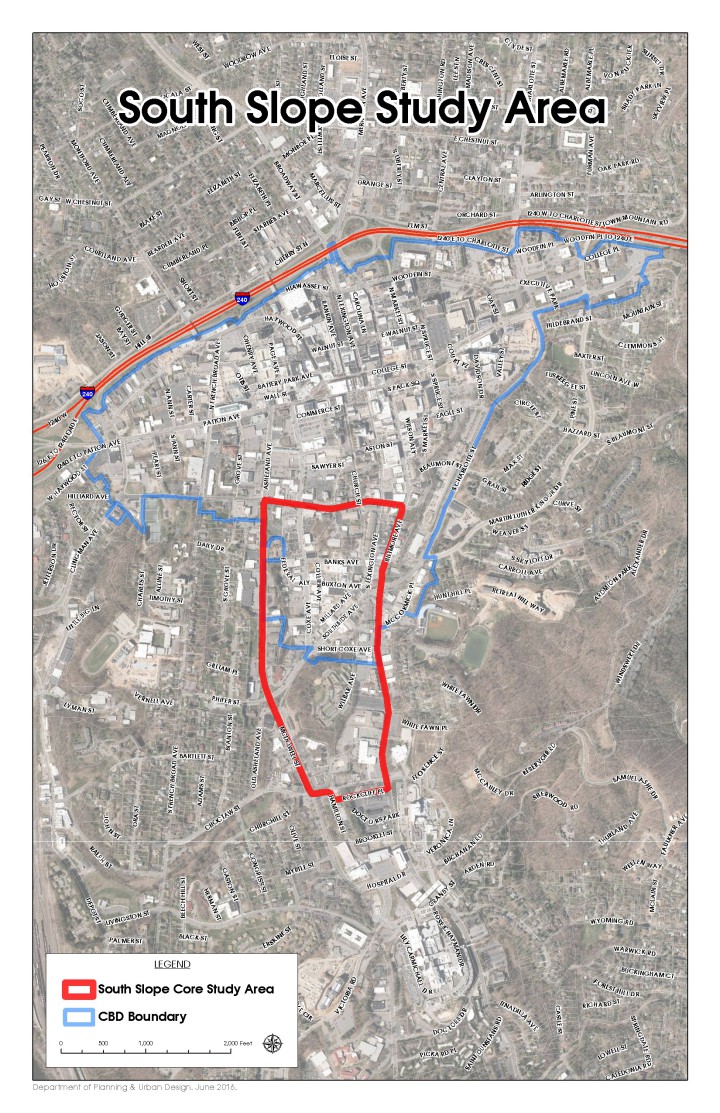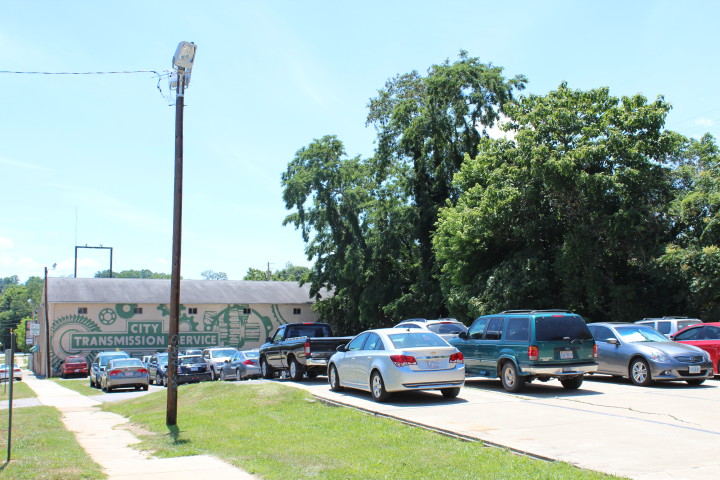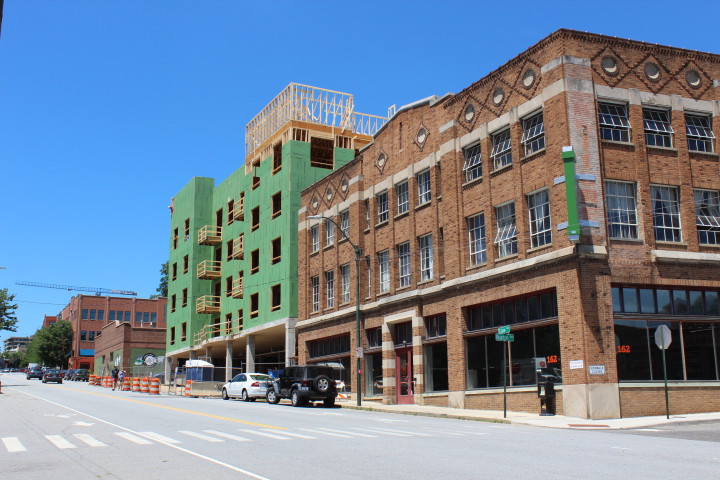On a beautiful summer afternoon, downtown Asheville can feel like a shirt that’s shrunk in the wash — suddenly too small for all it’s trying to contain. The sidewalks and streets are full, parking’s impossible, and when it comes to moving around, well, that shirt is so tight you can’t even swing your arms.
But complaining about the crowds is one thing — coming up with viable solutions is another. And while some city residents have called for a freeze on downtown development or scaling back the ad campaigns that lure tourists here, both city and tourism officials are understandably loath to turn their backs on that revenue stream.
So instead of curtailing the number of visitors, Asheville has a different idea: Why not expand the popular downtown? That’s the gist of a pitch the city is making to the Buncombe County Tourism Development Authority, seeking a massive grant to fund infrastructure that could support continued growth in the booming South Slope district.
Asheville is asking the TDA’s Tourism Product Development Fund for $20 million, spread over seven years, to pay for improving streets as well as pedestrian and bicycle access around the intersection of Biltmore Avenue and Charlotte Street, and a new parking deck on Southside Avenue. If approved, the money would come through the fund’s “major works pathway,” which enables the TDA to make multiyear commitments to big projects that align with its strategic objectives.
Major works
One-quarter of the money generated by Buncombe County’s 6 percent occupancy tax funds projects with the potential to increase overnight hotel stays, says Stephanie Pace Brown, executive director of the Asheville Convention and Visitors Bureau. The rest pays for advertising and marketing of Asheville as a tourism destination. Last year, the agency funded such projects to the tune of about $3.9 million.
When she joined the agency in 2012, notes Brown, she initiated a review of the application process for Tourism Product Development Fund grants. Subsequently, the TDA switched to a two-tiered process. First, the committee reviews all applications; those gaining approval are invited to submit more detailed second-round proposals.
“We wanted to lower the barrier to entry and give people with good projects that first level of feedback before they invested time and resources on a full-fledged application,” says Pace Brown.
The committee also now holds an information session, where the evaluation criteria are explained, before the initial application deadline (which was June 1 this year). In addition, the committee is using scorecards to evaluate projects.
In March 2015, the TDA adopted two more changes in the way it awards grants. First, the authority’s board now approves a “strategic priority list” for projects it plans to fund if and when additional money becomes available. In February, for example, the board voted to release an additional $700,000 during the 2015-16 fiscal year to fund a 1.5-mile section of the French Broad River Greenway, bringing its total investment in city-owned projects during that period to $3.1 million. Although the $700,000 was on the strategic priority list, the authority couldn’t release the funds until they’d actually been collected as tax payments.
The second change the TDA made was creating a “major works pathway” for multiyear projects. In effect, Brown explains, the agency was “saying there are these large, probably municipal, projects that should be considered separately.”
Applications for that funding are considered outside of the usual timetable and procedures. This gives applicants added flexibility to accommodate things like federal or state grant deadlines or the need to incorporate public input into the planning process. “These big development projects have so many different pieces, and they rarely coincide with when the TDA application deadline falls,” notes Brown.
The major works pathway also enables the TDA to consider broader strategic goals when awarding funds generated by the occupancy tax. According to a report prepared by the Magellan Strategy Group, “It provides a more proactive approach to filling strategic gaps, rather than simply reacting to what is presented through the TPDF application cycle.”
In addition, Brown points out, “The collaboration is starting at the front instead of at the end, and I think that’s a tremendously positive step.”
There are some risks with this approach, the report notes. Big commitments can reduce or even eliminate potential funding for other projects. In addition, focusing on one or two larger projects rather than a number of smaller ones increases the impact should those projects fail. And because the actual amount of future occupancy tax revenues can’t be known in advance, large projects could suffer if promised funds weren’t available on schedule.
Brown says she expects the product development committee to consider those issues as it sifts through the $8.9 million worth of proposals it received June 1, in addition to the city’s $20 million application (the only major works proposal now being considered). Based on revenue projections, the TDA expects to have about $14.4 million to spend on promoting the area in the 2016-17 fiscal year, according to a draft budget presented at the agency’s May 25 board meeting. Twenty-five percent of room tax receipts will yield about $3.7 million for local project grants. The city’s request to fund South Slope infrastructure, Brown points out, doesn’t ask for payment in either the current or the following fiscal year, meaning the $3.7 million projected for next year’s projects would be available for shorter-term grants.
And despite the challenges, Brown says she’s excited about the new pathway. “I really like the spirit of collaboration that’s inherent in this process,” she reveals. “The TDA is saying, ‘We want to be partners with the municipalities to do significant works that benefit both the community and our objectives of attracting visitors.”
Infrastructure to the rescue
At a June 7 meeting of the South Slope Neighborhood Association, city officials presented their ideas about what $20 million in TDA funding could do for the area.
The proposed improvements, which City Council approved as part of the May 17 consent agenda, evolved out of the recommendations of the recent Asheville In Motion multimodal transportation plan and concerns about a growing shortage of parking on the booming South Slope.

Making Biltmore, Coxe and South Lexington avenues “complete streets” that accommodate pedestrians, bicycles and mass transit as well as cars would create a stronger connection between South Slope and downtown, Assistant City Manager Cathy Ball explained. In addition, she continued, it would reduce congestion in the central business district by spreading visitors over a larger area. The city, noted Ball, is also applying for a state transportation grant to fund some of the street improvements.
A chunk of the TDA money would go toward a new $15.5 million parking deck and mixed-use structure at 42-44 Southside Ave. on a surface parking lot owned by Asheville Gastroenterology Associates. The idea arose when the practice applied for a permit to re-grade, level and pave the lot, which it now uses for employee parking. Dr. David May, the practice’s president and managing partner, said leveling the lot would allow for about 25 additional spaces.
Asheville Gastroenterology, he explained, has grown significantly since building its Biltmore Avenue offices in 1991, creating a “desperate need for additional parking” during daytime hours. A city parking deck, on the other hand, would see the greatest demand during evening and weekend hours. “On a Friday night,” he added, “There is absolutely no parking in this area.”
May agreed to wait 90 days while the city conducts a feasibility study for the project.
If plans for the deck move forward, said Ball — who was part of a local contingent that recently attended an energy planning workshop in Utah — the city will also seek grants to fund a renewable energy installation with battery storage on the structure. Another possibility being considered for the upper levels is affordable housing.
City staff members, noted Ball, also want to explore creating better, safer pedestrian and bicycle connections linking South Slope breweries and restaurants to McCormick Field and, eventually, the planned Beaucatcher Greenway. In its current form, the intersection of Biltmore and Southside avenues and Charlotte Street “does not feel safe,” she said. One idea is a pedestrian bridge over Biltmore Avenue.

The final proposed component is a South Slope gateway that would define the area and welcome visitors arriving from the south. The precise location hasn’t been determined yet, but the Biltmore/Southside intersection is a prime contender. “We don’t know exactly what that would look like,” Ball told the South Slope stakeholders, “but we think of the project in terms of placemaking.” Area businesses, she noted, have done a great job of creating an identifiable sense of place for the emerging district, and the city hopes to benefit from their input during the planning process.
Residents weigh in
After Ball and other speakers had outlined the proposed investments, South Slope residents and business owners posed various questions.
Displaying a map of the area in question, Planning Director Todd Okolichany explained that the exact boundaries will be determined by “a full visioning effort with your community, focusing on the South Slope Innovation District and neighborhood,” which will probably span many months. The target area for the exercise, he said, might continue down Biltmore to include the Mission Health campus and the Lee Walker Heights public housing community, which is also slated for redevelopment.
Architect Brent Campbell, who has an office on Banks Avenue, asked how the South Slope community can best present a unified voice during the planning process. Okolichany said that while planning for the effort is still in the early stages, it may involve “small group sessions, interviews with stakeholders and larger group dialogues.”
Mike Figura, co-owner of a building at 207 Coxe Ave., said he was pleased to see the city and the TDA partnering on a major project. “We really need a parking deck in South Slope,” he continued. “Many of the undeveloped lots in the area are going to get redeveloped, which will further reduce the available parking.”
Campbell sounded a similar note after the meeting, saying, “The need for more parking in the area has increased exponentially over the past four years. From noon on, you just can’t get a spot.”
South Slope residents at the meeting said they welcomed the dialogue with the city, but some were unhappy about the pace and nature of recent development.
“What are you doing for the residents that live here?” queried Diane Beck, who lives part of the year in The Aston, a 14-unit condominium building at the corner of Sawyer and Church streets. After the meeting, Beck and her husband said they’ve seen a marked increase in foot traffic over the 10 years they’ve owned their condo on “the quiet little street surrounded by churches.”
“The commercial people are highly in favor of this,” argued Charlie Beck, “but it seems like residents are further down the list.” The city, they maintained, needs to make more effort to address residents’ concerns.
Saundra Lemaster, who’s lived in a Lexington Station condo for the last six years, said street improvements are needed. “There are definitely bottlenecks,” she noted, adding that she’s “happy to see the growth, and happy that it appears the city is willing to listen and work with us.”
A long road
Even if Asheville gets the $20 million, it won’t cover all the proposed improvements. On June 6, says Ball, the city applied for $4 million in state Transportation Department funding. Another $3 million could come from the parking enterprise fund (revenue from city parking lots and garages) and $1 million from the general fund. Ball says the city might seek $2 million in energy-efficiency grants for the parking deck’s renewable energy features.
Big development projects necessarily entail disruption that often makes someone unhappy.
At the June 7 South Slope meeting, however, Brown said, “It’s very important to the TDA and the city that stakeholder communities feel excited and good about this investment.”
“The vitality of downtown,” she maintains, “is an important aspect of the health of tourism in this community. There are impacts on downtown caused by tourism that we can help to address.”
And if the project does get funded, stresses Brown, “It benefits all of downtown, because it can disperse visitors into a bigger footprint. It also helps the small-business community by helping spread the visitor spending around and reducing the congestion and the impact on the core areas.”
The committee will meet June 23 to consider the project for the first time; there’s no specified timeline for making a decision.
And in any case, she emphasizes, both the city and the TDA face “a long process” to get from the current conceptual plan to an approved project with funding commitments. The scope needs to be agreed on, preliminary designs and plans must be completed, public input must be incorporated, and other funding must be secured. Meanwhile, many factors that are beyond local control can affect future tourism revenues.
Despite these challenges, however, Asheville is hoping to trade that shrunken shirt for a roomier model. For her part, Ball says she’s “thrilled” that the TDA is considering the city’s proposal. “These improvements are focused on expanding the places people can be and feel like they’re still part of downtown,” she concludes.
Editor’s note: This story was UPDATED on June 22 to reflect a correction in our reporting on the TDA’s proposed budget for the 2016-2017 fiscal year that will begin on July 1. The $14.4 million proposed budget reflects 75 percent of the projected hotel room tax revenues in Buncombe County. The TDA estimates that $3.7 million (which represents 25 percent of tax revenues) will be available for local projects.





“Asheville has a different idea…”
OH, does “it”?
It seems to me that individual business owners had “the idea” and now “Asheville” is having an oh shit moment once again – trying to figure out how to keep up with the folks who had the vision in the first place.
Exactly, Jeff. Now that the south slope is mostly developed the keystone kop council runs in as if they had anything to do with it. We’re from the government and we are here to help should always scare you.
This is
The city does realize that, as part of the Central Business District, the South Slope is already part of downtown, right? Included in the (mostly ignored) Downtown Master Plan?
Hi indy499, I know the provided map isn’t the most illuminating, but you can see from it how the CBD and the proposed South Slope area make a Venn diagram-type of configuration in which there is overlap. The proposed South Slope does however extend a good ways outside the downtown. City Planning Director Todd Okolichany did point out at the neighborhood meeting that the Downtown Master Plan does apply to part of the area and will be incorporated into the visioning. The article was already pretty wonky and I hesitated to throw in references to all the applicable existing policy documents. But Okolichany and Cathy Ball did both mention several current plans that are relevant to plans for the area.
Thanks for bringing that up.